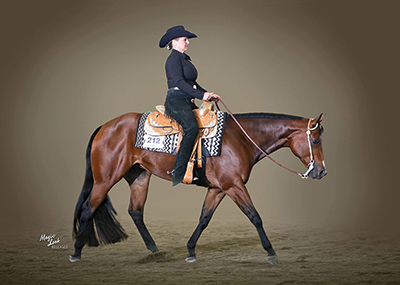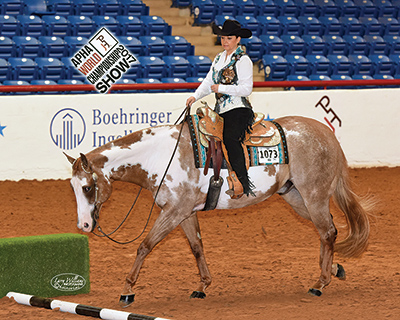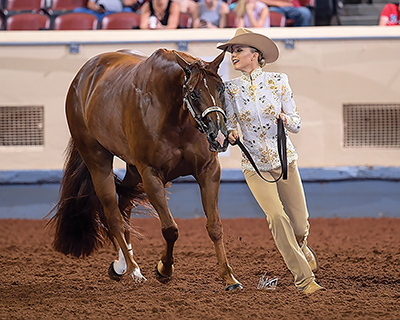
Julie McCallister
When Julie McCallister became an empty-nester it was time to chase her horse show dreams. She purchased Hour Rumors, “Trixie,” and began training with Kip Larson and Michael Davis at Kip Larson Performance Horses for Western Pleasure. Then she added Halter, Hunter Under Saddle, Showmanship, Horsemanship, and Equitation. Earlier this year she won the AQHA Level 1 West All-Around title, among other top finishes.
“I believe Kip and Mike thought I was a little nuts to want to ride my western horse in Hunter Under Saddle, but with a little work we discovered Trixie really could trot,” she said.
McCallister’s motivation for riding multiple events was to combat boredom at shows.
“I had long waits in between classes,” said the Enumclaw, Washington exhibitor.
For Walworth, New York competitor Susie Roncone the all-around events calmed her show ring jitters. In her first few years showing Wa Ta Hot Invitation, “Wyatt,” in one or two events she was anxious. She showed extensively as a youth and regularly spoke in front of hundreds of people at a time at work.
“I knew this was unusual for me. I began to think my horse show ring jitters were due to sitting around all day and anticipating that one ride,” she said. “When that one ride fell short of my expectations, the nerves compounded.”
She changed up the routine, entered multiple classes and didn’t have time to be nervous. She and Wyatt have accumulated open and amateur performance ROMs, 14 open all arounds and six amateur all arounds. At one show in 2016, she was crowned the open all around, amateur all around and novice high point winner under both judges.
“We began to have fun, win or lose, and a renewed sense of confidence surfaced,” she said. “I still get butterflies, but they’re a good kind of butterflies.”

Melissa Haberkorn
Paint exhibitor Melissa Haberkorn and VR Knockyour Socksoff are among the toughest all-around exhibitors to beat. Last year, the pair won the All-Around Masters Amateur title at the APHA World Show and are the leading Open and Amateur point earners in Trail.
“He’s a once in a lifetime horse and we have we have gotten to know each other so well,” she said. “I never watch the points board, it took all the fun out of it. I let everyone else do that for me.”
Other riders like Mallory Vroegh start with the goal of finding an all-around horse. The Grimes, Iowa youth rider has shown Krymsun Belle to multiple youth AQHA and NSBA world and reserve championships and several all-around titles.
The 2018 AQHA Level 1 East 14-18 All Around Champion Nicole Griffo of Cicero, New York leased Chocolates Hot Assets, “Lenny,” to learn new events, specifically Trail. The pair also competed in Showmanship and Horsemanship.
“Showing multiple events on one horse can be challenging especially at longer shows,” she said. “It can be tough to show all day and then practice the next set of patterns.”
But each of these riders wouldn’t trade in the challenges for an easier show schedule. So, what has made these riders successful at the all-around? The right horse, a show plan and lots of hours in the saddle.
Read on to learn how these riders have done it and find tips from top all-around trainers for achieving your goals.
 Finding the right horse
Finding the right horse
Specialization makes it difficult to find a horse that can excel. And it takes years to develop a finished all-around horse. Along with patience and hard work it takes certain qualities for success.
“It takes stamina and will,” said Atlanta, Georgia trainer Clint Ainsworth. “I don’t like a horse that is lazy or one that is high energy, but one that has grit and power.”
Depending on the size of the show and the number of gos the horse may compete six to eight times in one day. That makes tenacity critical.
“The horse has to have a little more physical energy, not nervous energy, and want to work all day without getting grumpy,” said Carly Parks, an APHA Pro Team member of Sabina, Ohio.
Size matters. A horse that’s too large will have difficulty making tight turns. A horse that’s too small likely won’t have the length of stride to extend and hit marks. But Ainsworth emphasizes that every horse is different. Some 16.1 hand horses “pony” trot and lack the natural ability to produce a pretty stride. Conversely, there are 15.1 horses that have breathtaking extensions. He’s had clients win World Championships in Equitation aboard 15.2 horses and All-Around titles aboard 15.1 horses.
Davis encourages clients to choose taller horses, between 15.3 and 16 hands when it makes sense. Even though these horses may be a little harder to fit into a small trail box, he has found that bigger horses tend to sell better down the road.
Trainer Shannon Vroegh, also Mallory’s mom, believes that the best size for all-around horses is within an inch or two of 16 hands. She feels this height enables the horses to perform well on the rail and in patterns.
Parks looks at the horse’s neck and stride length more than height.
“A little bigger stride usually makes a pretty picture in horsemanship when the horse is covering ground rather than bouncing the rider along,” she said.
“What’s more important is that the horse is a true mover, not a man-made mover,” Ainsworth added.
Many all-around trainers watch the Western Pleasure pen for prospects. Davis finds pleasure horses are agile and move off the rider’s spur making it easier to train them for a new event. Parks believes that since Western Pleasure horses have self-carriage and listen to a rider’s feet that they already have the buttons needed to move on to other events.

Mallory Vroegh
Show Day Strategy
Increasing the number of classes entered increases the chances for earning enough points for an all-around title. However, there are numerous opportunities for winning an all-around without competing in every single class. In fact, Shannon encourages clients to become the best in a couple of events rather than placing in the middle of the judge’s card in several classes.
Vroegh’s strategy is an effective one for riders who enter the largest classes. At most shows today Western Pleasure, Showmanship, Horsemanship, Trail and Western Riding have the largest number of entries, Davis said.
“I’ve had riders win an all-around after competing in only three or four classes,” Ainsworth said.
Fewer riders in Hunter Under Saddle and Equitation classes is a reflection the number of select riders participating in shows compared with other demographics.
“These riders don’t want to do English as much and it can be a little harder physically for them,” Ainsworth said.
Since Showmanship is typically a full point class, Haberkorn puts extra effort into doing well there.
“I try to start the show out strong with a good Showmanship class to boost my confidence and give us points,” she said. “When I make a huge blunder in the class and don’t even get one point I’m already in the hole and have to work harder the next two days.”
Haberkorn knows Sock’s strengths. Since he is not the best Western Pleasure mover, she concentrates on patterns where she knows she can do well. Similarly, Roncone recognizes that Western Pleasure for a 16.2 horse has its challenges, but that’s what keeps her entering the pen at every show.
“I absolutely love showing Western Pleasure. It’s a class of guts and trust, and being on a 16.2 hand horse makes it even more challenging,” she said. “On the flip side, letting him run in the speed classes has become my treat to him. Not only do I have fun, but Wyatt has fun too.”

Susie Roncone
There are challenges to wanting to do it all. There’s not much time to relax and no rest for the weary.
“Getting tired at the horse shows is our biggest challenge,” Mallory said. “We both get tired and that sometimes makes us not great at every event every day.”
McCallister agrees, it can be a challenge.
“You have to change your tack, change your clothes and convince your horse to move a bit different,” McCallister said. “You also have to memorize and practice all those patterns.”
It’s also important to have a supportive trainer.
“Even though Mike will give me a ‘you’re kidding me look’ when I tell him I want to try a new event, he supports my desire to have a great all-around horse,” McCallister said.
Conclusion
All-around horses aren’t developed overnight. Ainsworth said it can take years to build a nice all-around horse and there will be ups and downs. It also takes a dedicated rider who is willing to put in the time for the additional practice to be successful in the all-around.
Now that Socks is 19 Haberkorn must be cognizant of his age. She plans to continue showing him because he is healthy and is eager to perform, but she says she probably won’t go after an all-around title at a one-day show because of the physical demands.
Soundness is critical for any event, but especially for all-around horses. You’re going to ask a lot of them by going all day. There’s nothing worse than getting one finished and then have them not hold up, Parks said.
“All-around horses are just very special. Their brains are programmed a little different, just like people,” Haberkorn said.
As McCallister prepares to add another event in 2018, Trail, she has one piece of advice that every exhibitor can use.
“If you have a class that doesn’t go as planned, brush it off and move on. Show your equine partner some love and try again another day,” she said.


You must be logged in to post a comment Login